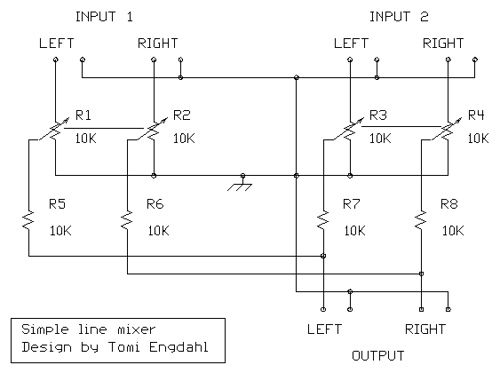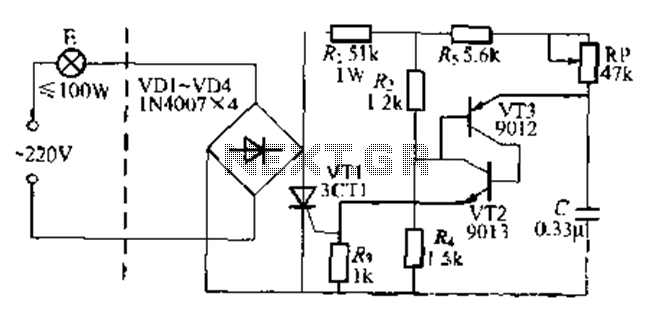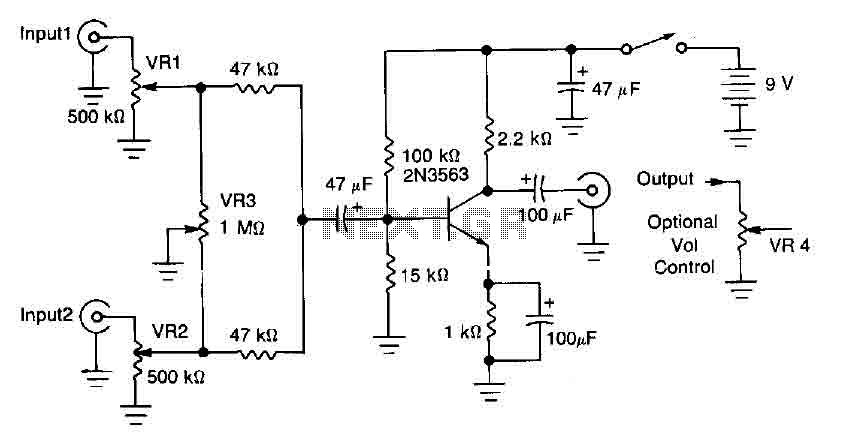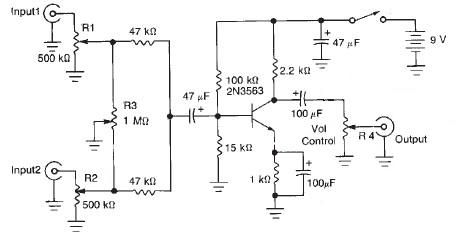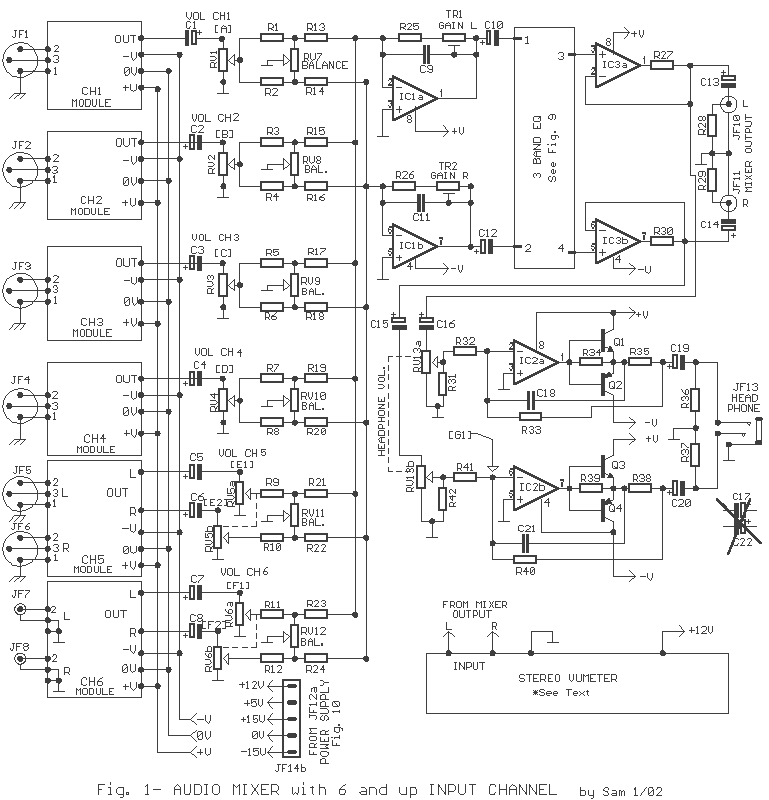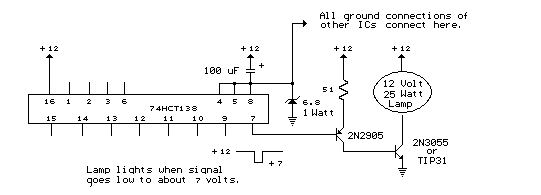
drm direct mixer ef956ak5
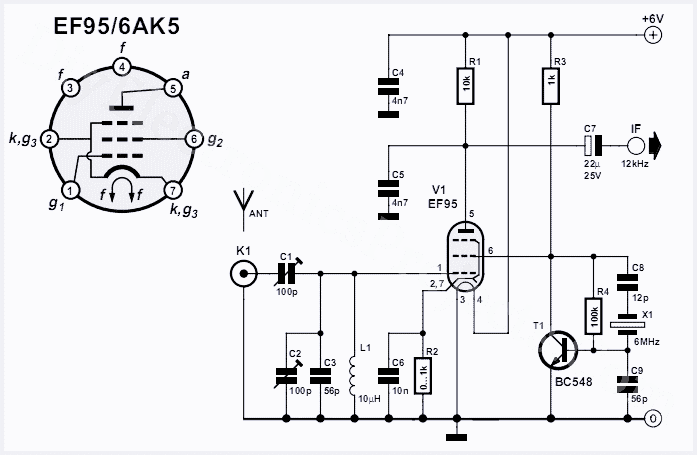
This hybrid DRM receiver with a single valve and a single transistor exhibits excellent large-signal stability. The EP95 (US equivalent: 6AK5) functions as a mixer, with the oscillator signal introduced via the screen grid. The crystal oscillator is constructed around a single transistor. The entire circuit operates from a 6-V power supply. The receiver achieves a signal-to-noise ratio of up to 24 dB for DRM signals, indicating that the valve performs comparably to an NE612 IC mixer. The component values specified in the schematic have been chosen for the RTL2 DRM channel at 5990 kHz, allowing for the use of a cost-effective 6-MHz crystal. The input circuit is designed with a fixed inductor, while two trimmer capacitors enable optimization of antenna matching. The operating point is determined by the value of the cathode resistor. Increasing the cathode resistor's value can enhance grid bias and input impedance, although satisfactory performance can also be attained with the cathode directly connected to ground.
This hybrid DRM receiver circuit integrates a single valve (EP95) and a single transistor to provide robust performance characterized by significant large-signal stability. The EP95 valve operates as a mixer, enabling the processing of DRM signals. The oscillator signal is injected into the mixer via the screen grid, which is a critical point for achieving the desired mixing process. The crystal oscillator, essential for frequency stability, is implemented using a single transistor, which contributes to the overall compactness and efficiency of the design.
The circuit is powered by a 6-V supply, making it suitable for various applications where low power consumption is essential. The receiver's design allows it to achieve an impressive signal-to-noise ratio of up to 24 dB, making it competitive with more complex integrated solutions such as the NE612 IC mixer. This performance metric is crucial for ensuring clear reception of DRM signals, especially in environments with potential interference.
The component values in the schematic are specifically tailored for the RTL2 DRM channel operating at 5990 kHz. This careful selection allows for the use of an economical 6-MHz crystal, which is a significant advantage in terms of cost-effectiveness and availability. The input circuit employs a fixed inductor, which aids in maintaining circuit stability and performance consistency.
Two trimmer capacitors are incorporated into the design to facilitate antenna matching optimization. This feature is vital for maximizing the receiver's sensitivity and overall performance, enabling it to adapt to varying antenna characteristics and environmental conditions. The operating point of the valve is controlled by the cathode resistor value, which is a critical parameter in determining the receiver's performance. Adjusting the cathode resistor can enhance the grid bias and input impedance, allowing for fine-tuning of the receiver's response. However, it is notable that satisfactory operation can still be achieved with the cathode directly grounded, providing flexibility in circuit design and implementation.This hybrid DRM receiver with a single valve and a single transistor features good large-signal stability. The EP95 (US equivalent: 6AK5) acts as a mixer, with the oscillator signal being injected via the screen grid.
The crystal oscillator is built around a single transistor. The entire circuit operates from a 6-V supply. The receiver achieves a signal-to-noise ratio of up to 24 dB for DRM signals. That means the valve can hold its own against an NE612 IC mixer. The component values shown in the schematic have been selected for the RTL2 DRM channel at 5990 kHz. That allows an inexpensive 6-MHz crystal to be used. The input circuit is built using a fixed inductor. Two trimmer capacitors allow the antenna matching to be optimized. The operating point is set by the value of the cathode resistor. The grid bias and input impedance can be increased by increasing the value of the cathode resistor. However, good results can also be achieved with the cathode connected directly to ground. 🔗 External reference
This hybrid DRM receiver circuit integrates a single valve (EP95) and a single transistor to provide robust performance characterized by significant large-signal stability. The EP95 valve operates as a mixer, enabling the processing of DRM signals. The oscillator signal is injected into the mixer via the screen grid, which is a critical point for achieving the desired mixing process. The crystal oscillator, essential for frequency stability, is implemented using a single transistor, which contributes to the overall compactness and efficiency of the design.
The circuit is powered by a 6-V supply, making it suitable for various applications where low power consumption is essential. The receiver's design allows it to achieve an impressive signal-to-noise ratio of up to 24 dB, making it competitive with more complex integrated solutions such as the NE612 IC mixer. This performance metric is crucial for ensuring clear reception of DRM signals, especially in environments with potential interference.
The component values in the schematic are specifically tailored for the RTL2 DRM channel operating at 5990 kHz. This careful selection allows for the use of an economical 6-MHz crystal, which is a significant advantage in terms of cost-effectiveness and availability. The input circuit employs a fixed inductor, which aids in maintaining circuit stability and performance consistency.
Two trimmer capacitors are incorporated into the design to facilitate antenna matching optimization. This feature is vital for maximizing the receiver's sensitivity and overall performance, enabling it to adapt to varying antenna characteristics and environmental conditions. The operating point of the valve is controlled by the cathode resistor value, which is a critical parameter in determining the receiver's performance. Adjusting the cathode resistor can enhance the grid bias and input impedance, allowing for fine-tuning of the receiver's response. However, it is notable that satisfactory operation can still be achieved with the cathode directly grounded, providing flexibility in circuit design and implementation.This hybrid DRM receiver with a single valve and a single transistor features good large-signal stability. The EP95 (US equivalent: 6AK5) acts as a mixer, with the oscillator signal being injected via the screen grid.
The crystal oscillator is built around a single transistor. The entire circuit operates from a 6-V supply. The receiver achieves a signal-to-noise ratio of up to 24 dB for DRM signals. That means the valve can hold its own against an NE612 IC mixer. The component values shown in the schematic have been selected for the RTL2 DRM channel at 5990 kHz. That allows an inexpensive 6-MHz crystal to be used. The input circuit is built using a fixed inductor. Two trimmer capacitors allow the antenna matching to be optimized. The operating point is set by the value of the cathode resistor. The grid bias and input impedance can be increased by increasing the value of the cathode resistor. However, good results can also be achieved with the cathode connected directly to ground. 🔗 External reference
